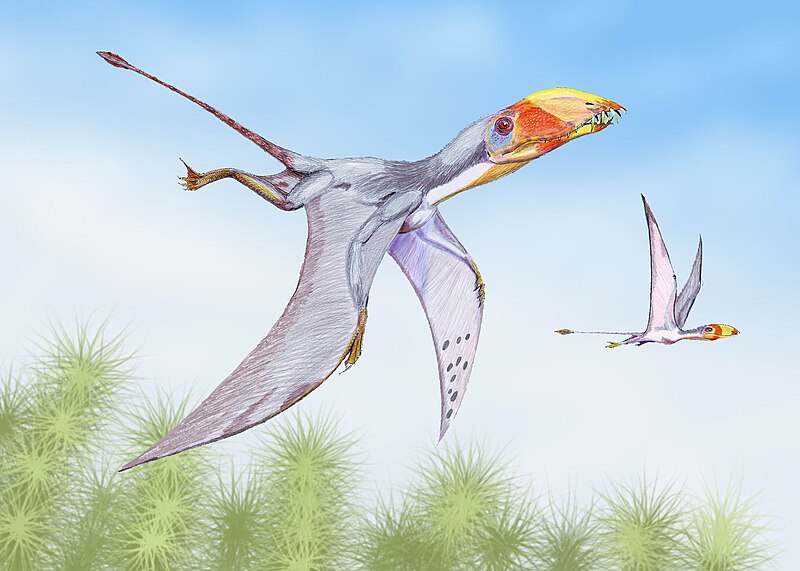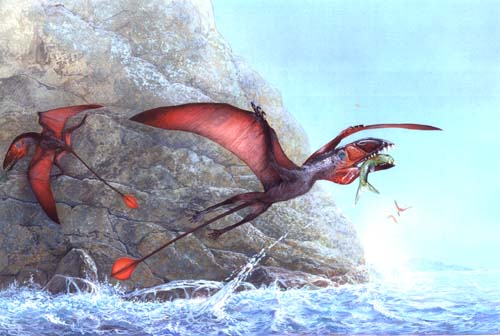[Recent Entries][Archive][Friends][User Info]
| May 17th, 2012 | |
|---|---|
| 06:23 pm [industrialterro] [Link] |
Dimorphodon Диморфодон (двуформозуб) — вымершее летающее пресмыкающееся, жившее от 200 до 180 миллионов лет назад. Размах крыльев до 2 м, длина от кончика головы до кончика хвоста — 120 см, размер головы — до 30 см. Диморфодон – один из древнейших летающих динозавров (птерозавров), обитавший в юрском периоде. Этот ящер имел мощные крылья, размах которых составлял около 2 метров. Длина его тела с учётом хвоста составляла 1,2 метра, а размер головы около 30 сантиметров. Вытянутая передняя часть головы напоминала клюв, но, в отличие от аналогичной части тела современных птиц, он был усажен огромным количеством острых, загнутых назад зубов. Как на задних конечностях, так и на концах крыльев располагались острые когти. Всё это говорит о том, что диморфодон был хищником, но, судя по небольшим размерам, питался он в основном рыбой и насекомыми. Вероятно, диморфодоны могли не только летать, но и лазать по деревьям и даже несколько неуклюже передвигаться по суше, используя при этом все 4 конечности. Вид этот изучен довольно слабо, так как на данный момент были найдены останки лишь одного экземпляра на территории Англии. Вполне возможно, что диморфодоны обитали не только в Европе. Dimorphodon had a large, bulky skull approximately 22 centimetres in length, whose weight was reduced by large openings separated from each other by thin bony partitions. Its structure, reminiscent of the supporting arches of a bridge, prompted Richard Owen to declare that, in far as achieving great strength from light-weight materials was concerned, no vertebra was more economically constructed; Owen saw the vertebrate skull as a combination of four vertebrae modified from the ideal type of the vertebra. The front of the upper jaw had four or five fang-like teeth followed by an indeterminate number of smaller teeth; the maxilla of all exemplars is damaged at the back. The lower jaw had five longer teeth and thirty to forty tiny, flattened pointed teeth, shaped like a lancet. Many depictions give it a speculative puffin-like 'beak' because of similarities between the two animals' skulls. The body structure of Dimorphodon displays many "primitive" characters, such as, according to Owen, a very small brain-pan and proportionally short wings. The first phalanx in its flight finger is only slightly longer than its lower arm. The neck was short but strong and flexible and may have had a membraneous pouch on the underside. The vertebrae had pneumatic foramina, openings through which the air sacks could reach the hollow interior. Dimorphodon had an adult body length of 1 metre (3.3 ft) long, with a 1.45 meter (4.6 ft) wingspan. The tail of Dimorphodon was long and consisted of thirty vertebrae. The first five or six were short and flexible but the remainder gradually increased in length and were stiffened by elongated vertebral processes. The terminal end of the tail may have borne a Rhamphorhynchus-like tail vane, although no soft tissues have yet been found of Dimorphodon to confirm this speculation Owen saw Dimorphodon as a quadruped. He speculated that the fifth toe supported a membrane between the tail and the legs and that the animal was therefore very ungainly on the ground. His rival Harry Govier Seeley however, propagating the view that pterosaurs were warm-blooded and active, argued that Dimorphodon was either an agile quadruped or even a running biped due to its relatively well developed hindlimbs and characteristics of its pelvis. This hypothesis was revived by Kevin Padian in the nineteen eighties. However, fossilised track remains of other pterosaurs (ichnites) show a quadrupedal gait while on the ground and these traces are all attributed to derived pterosaurs with a short fifth toe. Dimorphodon's was elongated, clawless, and oriented to the side. David Unwin has therefore argued that even Dimorphodon was a quadruped, a view confirmed by computer modelling by Sarah Sangster. Our knowledge of how Dimorphodon lived is limited. It perhaps mainly inhabited coastal regions and might have had a very varied diet. Buckland suggested it ate insects. Later it became common to depict it as a piscivore (fish eater), though Buckland's original idea is more well supported by biomechanical studies. Dimorphodon had an advanced jaw musculature specialized for a "snap and hold" method of feeding. The jaw could close extremely quickly but with relatively little force or tooth penetration. This, along with the short and high skull and longer, pointed front teeth suggest Dimorphodon was an insectivore, though it may have occasionally eaten small vertebrates and carrion as well. In 1870 Seeley assigned Dimorphodon its own family, the Dimorphodontidae, with Dimorphodon as the only member. It was suggested in 1991 by German paleontologist Peter Wellnhofer that Dimorphodon might be descended from the earlier European pterosaur Peteinosaurus. Later exact cladistic analyses are not in agreement. According to Unwin, Dimorphodon was related to, though probably not a descendant of, Peteinosaurus, both forming the clade Dimorphodontidae, the most basal group of the Macronychoptera and within it the sister group of the Caelidracones. This would mean that both dimorphodontid species would be the most basal pterosaurs known with the exception of Preondactylus. According to Alexander Kellner however, Dimorphodon is far less basal and not a close relative of Peteinosaurus.
Репродукции (1, 2, 3, 4, 5, 6, 7, 8, 9, 10, 11, 12, 13, 14, 15):
Ископаемые останки (1, 2, 3, 4, 5, 6):
Tags: Вымершие рептилии, Юра, авеметатарзалии, архозавроморфы, архозавры, диапсиды, диморфодонтиды, птерозавры, рамфоринхоидеи |




















